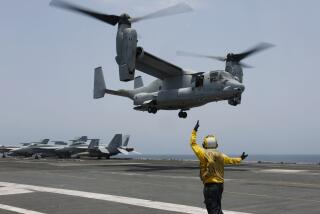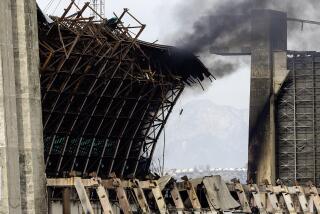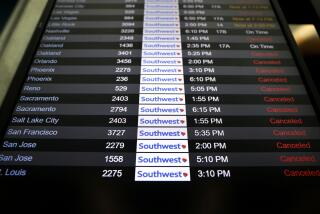El Cajon Firms Win Award for Navy Jet Crash Damage
The U.S. government was ordered to pay more than $2.5 million to compensate two El Cajon aviation firms for losses suffered when a disabled Navy jet fighter crashed in 1988.
Under Chief U.S. District Judge Judith N. Keepâs order, issued Wednesday, Skydance Helicopters Inc. Cajon will receive $1.5 million for lost profits, plus $600,000 for property damage and lost inventory.
Krauss Helicopters Inc. was awarded $364,000 for lost business profits, plus $100,000 for property damage and lost inventory.
The fiery crash of an F-14 Tomcat four years ago wiped out the companiesâ shared hangar at Gillespie Field. Keepâs order was filed at San Diegoâs federal court after lawyers for the government and the two firms worked out details of the award.
The order follows a non-jury trial that ended Nov. 5. Attorney Kevin F. Quinn, representing the helicopter companies, argued that his clients should be compensated not only for the damage suffered, but for persevering through bad economic times.
âOur clients believe (Judge Keep) gave us a fair shake,â Quinn said.
Assistant U.S. Atty. Michael E. Quinton, representing the government, was not available for comment.
The F-14, assigned to Fighter Squadron 124 at Miramar Naval Air Station, crashed at Gillespie Field Sept. 12, 1988, after the hydraulic system failed during a training mission.
The aircraftâs two-man crew ejected 2.5 miles from the airport. The radar-intercept officer, Lt.(j.g.) Randall L. Furtado, died of neck injuries a day later.
The crash set numerous buildings on fire at the civilian airport, destroyed several aircraft and injured four people on the ground.
In 1991, a federal judge awarded more than $2.8 million in damages to helicopter mechanic William Grant, who lost part of a leg in the crash. Grant and his wife had accused the Navy of improperly inspecting the jet before its ill-fated flight, and of allowing the jetâs hydraulic system to fall into disrepair.
More to Read
Inside the business of entertainment
The Wide Shot brings you news, analysis and insights on everything from streaming wars to production â and what it all means for the future.
You may occasionally receive promotional content from the Los Angeles Times.










